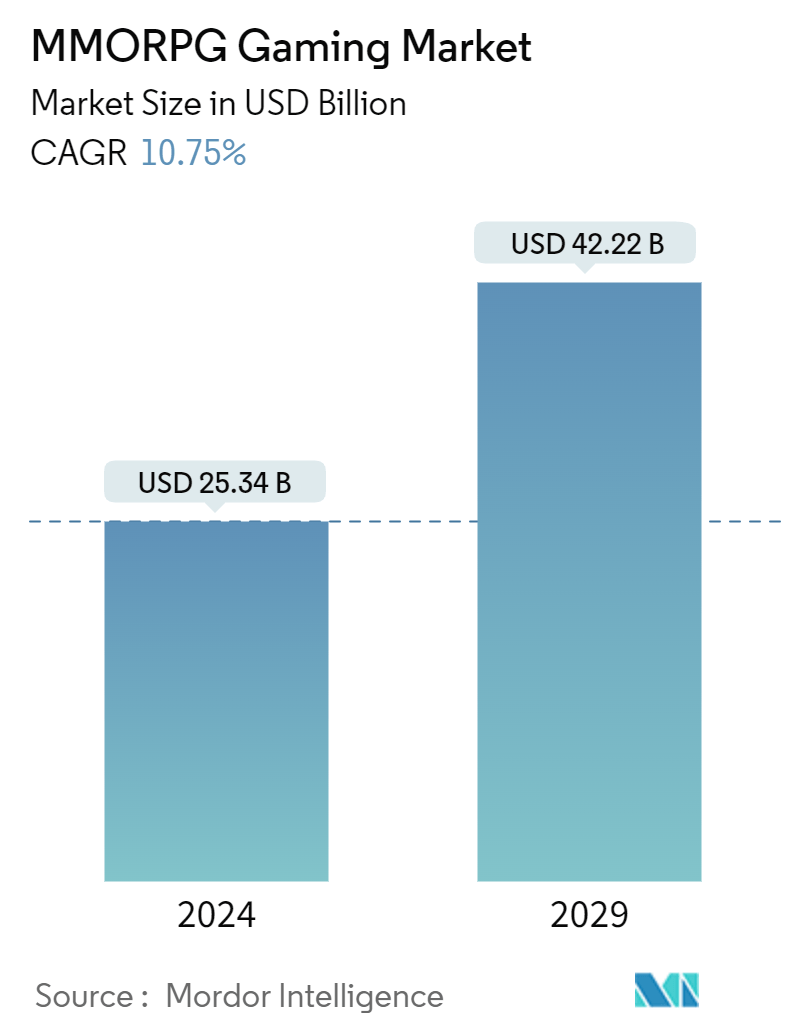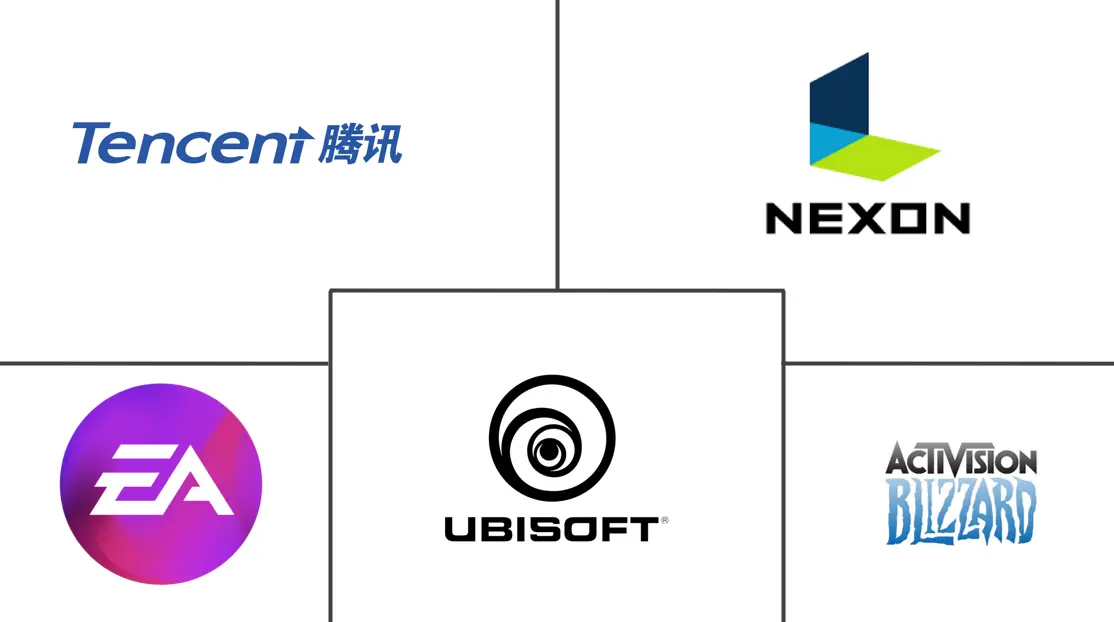Market Size of MMORPG Gaming Industry

| Study Period | 2019 - 2029 |
| Market Size (2024) | USD 25.34 Billion |
| Market Size (2029) | USD 42.22 Billion |
| CAGR (2024 - 2029) | 10.75 % |
| Fastest Growing Market | Latin America |
| Largest Market | Asia Pacific |
Major Players
*Disclaimer: Major Players sorted in no particular order |
MMORPG Gaming Market Analysis
The MMORPG Gaming Market size is estimated at USD 25.34 billion in 2024, and is expected to reach USD 42.22 billion by 2029, growing at a CAGR of 10.75% during the forecast period (2024-2029).
Technological advancements, such as enhanced graphics, more robust hardware, and faster internet speeds, are poised to bolster the MMORPG market. These upgrades promise an enriched gaming experience, ultimately driving higher player engagement and retention rates.
- The MMORPG games market is primarily propelled by a surge in technological advancements. Enhanced graphics and faster internet speeds are at the forefront, enriching the gaming experience and attracting a broader player base. Interactive gaming features are gaining traction, fostering community engagement and enhancing player loyalty.
- The rising popularity of e-sports and live-streaming platforms heightens visibility and interest. Ongoing revenue is fueled by subscription models and in-game purchases, incentivizing developers to maintain a focus on high-quality content. Moreover, as the global gaming audience expands, particularly in emerging markets, both the player base and market size are experiencing significant growth.
- MMORPGs create a distinct social environment, enabling players to engage and cooperate within a virtual realm. In a world growing ever more interconnected, MMORPGs serve as a hub for individuals to bond with similar gamers, fostering friendships and nurturing communities. This sense of fellowship and social engagement is a key draw for players, particularly those demanding connections and a community feel.
- MMORPGs commonly showcase elaborate progression systems, enabling players to elevate their character levels, obtain potent gear, and unveil fresh abilities. Players can benefit from the long-term progression and the sense of achievement it brings. Character development, the quest for rare items, and conquering obstacles offer players a fulfilling sense of achievement.
- With the global expansion of internet connectivity, an increasing number of individuals now have the ability to participate in online gaming. The increasing internet penetration, especially in emerging markets, broadens the player base potential for MMORPGs.
- For instance, as per the International Telecommunication Union, as of 2023, Europe boasted the world's highest internet penetration rate, with an overall percentage of 91%. Africa reported the world's lowest internet adoption, standing at a mere 37%. By the same year, the global internet user base tallied at around 4.9 billion individuals.
- The surge in e-sports, as well as competitive gaming, has bolstered the appeal of MMORPGs. MMORPGs that integrate competitive features, like player-versus-player combat and guild conflicts, draw in gamers keen on competition and eSports viewers. This symbiotic relationship between eSports and MMORPGs continues to drive the genre's popularity.
- Player retention and engagement are pivotal for MMORPGs, not just for maintaining their player base but also for revenue generation. However, sustaining long-term engagement poses challenges, with issues such as burnout, competition from new game releases, and evolving player tastes. When players disengage or shift to other titles, the repercussions can directly impede the growth trajectory of MMORPGs.
MMORPG Gaming Industry Segmentation
Massively multiplayer online role-playing gaming (MMORPG) can be defined as a genre of video games that combines elements of role-playing games (RPGs) and online multiplayer functionality. In MMORPGs, players assume the roles of characters within a virtual world, where they interact with many other players, often simultaneously, in a persistent online environment. The report tracks the adoption of different MMORPG games played through various gaming platforms such as mobile, tablet, gaming consoles, and PC. The study also focuses on the existing gaming developer landscape, which consists of major players operating in the market.
The MMORPG gaming market is segmented by gaming platform (mobile, tablet, gaming console, and PC) and geography (North America [United States and Canada], Europe [United Kingdom, Italy, France, Germany, Russia, and the Rest of Europe], Asia-Pacific [China, India, Japan, South Korea, and the Rest of Asia-Pacific], Latin America [Brazil, Mexico, Argentina, and the Rest of Latin America], and Middle East and Africa [United Arab Emirates, Saudi Arabia, South Africa, and the Rest of Middle East and Africa]). The market sizes and forecasts are provided in terms of value (USD) for all the above segments.
| By Gaming Platform | |
| Mobile | |
| Tablet | |
| Gaming Console | |
| PC |
| By Geography*** | |||||||
| |||||||
| |||||||
| |||||||
| Australia and New Zealand | |||||||
| |||||||
|
MMORPG Gaming Market Size Summary
The MMORPG gaming market is experiencing significant growth, driven by technological advancements such as enhanced graphics, robust hardware, and faster internet speeds. These improvements are enriching the gaming experience, leading to increased player engagement and retention. The market is further propelled by the rising popularity of e-sports and live-streaming platforms, which enhance visibility and interest. Subscription models and in-game purchases are key revenue drivers, encouraging developers to focus on high-quality content. The expanding global gaming audience, particularly in emerging markets, is contributing to the market's substantial growth. MMORPGs offer a unique social environment, fostering community engagement and player loyalty through interactive features and elaborate progression systems.
The proliferation of mobile gaming, especially on platforms like Android, is a significant trend in the MMORPG market. The advent of 5G and cloud gaming is set to further boost the market, providing smoother and more immersive gameplay experiences. The Asia-Pacific region, with its strong gaming culture and vast population, is a major contributor to the market's expansion. The region's adoption of 5G technology is enhancing mobile MMORPG experiences, making them more appealing to a broader audience. The market is characterized by a fragmented landscape with numerous global and regional players investing in research and development, strategic partnerships, and innovative solutions to strengthen their competitive positions.
MMORPG Gaming Market Size - Table of Contents
-
1. MARKET INSIGHTS
-
1.1 Market Overview
-
1.2 Industry Value Chain Analysis
-
1.3 Industry Attractiveness - Porter's Five Forces Analysis
-
1.3.1 Bargaining Power of Suppliers
-
1.3.2 Bargaining Power of Consumers
-
1.3.3 Threat of New Entrants
-
1.3.4 Threat of Substitute Products
-
1.3.5 Intensity of Competitive Rivalry
-
-
1.4 Assessment of COVID-19 Impact on the Market
-
-
2. MARKET SEGMENTATION
-
2.1 By Gaming Platform
-
2.1.1 Mobile
-
2.1.2 Tablet
-
2.1.3 Gaming Console
-
2.1.4 PC
-
-
2.2 By Geography***
-
2.2.1 North America
-
2.2.1.1 United States
-
2.2.1.2 Canada
-
-
2.2.2 Europe
-
2.2.2.1 United Kingdom
-
2.2.2.2 Germany
-
2.2.2.3 France
-
2.2.2.4 Italy
-
2.2.2.5 Russia
-
-
2.2.3 Asia
-
2.2.3.1 China
-
2.2.3.2 India
-
2.2.3.3 Japan
-
2.2.3.4 South Korea
-
-
2.2.4 Australia and New Zealand
-
2.2.5 Latin America
-
2.2.5.1 Brazil
-
2.2.5.2 Mexico
-
2.2.5.3 Argentina
-
-
2.2.6 Middle East and Africa
-
2.2.6.1 United Arab Emirates
-
2.2.6.2 Saudi Arabia
-
2.2.6.3 South Africa
-
-
-
MMORPG Gaming Market Size FAQs
How big is the MMORPG Gaming Market?
The MMORPG Gaming Market size is expected to reach USD 25.34 billion in 2024 and grow at a CAGR of 10.75% to reach USD 42.22 billion by 2029.
What is the current MMORPG Gaming Market size?
In 2024, the MMORPG Gaming Market size is expected to reach USD 25.34 billion.

